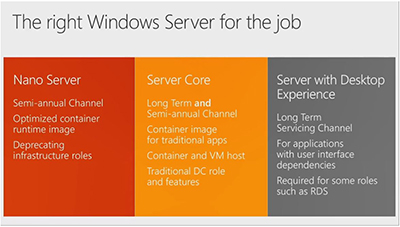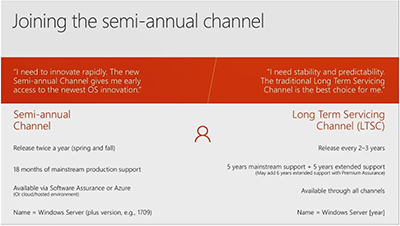News
Microsoft Releases First Semiannual Windows Server 2016 Update
Windows Server version 1709 was released on Tuesday, Microsoft announced.
Under this service-enabled scheme, which follows the update models that Microsoft has already set for Windows 10 and Office 365 ProPlus, organizations can expect two major software updates per year, in the spring and fall. Each semiannual channel release is supported for 18 months before an organization would need to move to the next channel release or lose support, meaning no security updates. Users of Windows Server version 1709 are required by Microsoft to have Software Assurance on top of their server licensing to use this service-enabled product.
Deployment Options
Windows Server version 1709 also restricts an organization's deployment options. They can't use the "Server with Desktop" experience with a graphical user interface (GUI). Instead, they have to use "Server Core," a smaller footprint option without a GUI that entails using remote management tools.
"If you are installing Windows Server, version 1709, Server Core is your only installation option, while Windows Server 2016 offers both the Server Core and Server with Desktop Experience installation options," Microsoft explained in this Windows Server article.
Moreover, it's not possible with Windows Server 2016 to switch between the desktop and core interfaces without performing a server OS reinstall.
Organizations wanting to use Nano Server, Microsoft's smallest footprint deployment option, also must use the Windows Server semiannual channel product. Nano Server is not an option for users of the long-term servicing channel Windows Server 2016 product. A table in this Microsoft document illustrates those deployment options and restrictions. Microsoft also has restricted Nano Server's role. It's just for use with containers, and can't be used to host workloads anymore.
The following Ignite slide summarizes the deployment options:
 [Click on image for larger view.]
Figure 1. Three deployment options for the two Windows Server channel models. Source: Microsoft Ignite 2017 session.
[Click on image for larger view.]
Figure 1. Three deployment options for the two Windows Server channel models. Source: Microsoft Ignite 2017 session.
One way that Microsoft perhaps is compensating for the lack of a desktop GUI when using Windows Server version 1709 is its latest remote server tooling called "Project Honolulu." It's at the preview stage right now, but Microsoft recommends using Project Honolulu to manage Windows Server version 1709. Project Honolulu is a replacement for the earlier Server Management Tools product. Both tools run from a browser for remote server management, so there is at least a browser-based GUI to use, although Project Honolulu isn't supported on Internet Explorer. Microsoft is even suggesting that Project Honolulu will be capable of all management tasks, so that IT pros won't be required to use PowerShell for certain tasks.
Traditional Model Lives On
The more traditional Windows Server release approach, in which Microsoft issues new OS updates about every two to three years, is still an option for users of Windows Server 2016. Microsoft now refers to that traditional update model as the "long-term servicing channel" option. Software Assurance, which may add around 25 percent on top of server licensing costs, isn't required when going with the traditional release-model approach.
Windows Server 2016 users following the long-term servicing channel approach can deploy using the Server Core or the Server with Desktop options. However, they don't have access to the Nano Server deployment option.
The traditional Windows Server 2016 long-term servicing channel model follows Microsoft's standard lifecycle product support policy, which consists of five years of "mainstream support" plus five years of "extended support." Microsoft this week started publishing "Windows Server Release Information" at this page. In a table, it shows the more truncated mainstream support phase for the Windows Server version 1709 semiannual channel release compared with the long-term servicing channel approach.
Microsoft does not support an "in-place upgrade" from Windows Server 2016 to Windows Server version 1709. The reason, according to commenter "Vinicius Apolinario" in the comments section of Microsoft's Tuesday announcement, is that the two products have "different support lifecycles." While many IT pros might shudder at the thought of performing an in-place upgrade of Windows Server, Microsoft currently backs that method for Windows 10 client upgrades.
The following Ignite slide summarizes the two update models for Windows Server:
 [Click on image for larger view.]
Figure 2. The two channel options for Windows Server.
Source: Microsoft Ignite 2017 session.
[Click on image for larger view.]
Figure 2. The two channel options for Windows Server.
Source: Microsoft Ignite 2017 session.
Availability
Windows Server version 1709 (Standard or Datacenter editions) can be downloaded from Microsoft's Volume Licensing Service Center portal. Microsoft mentioned on Tuesday that it is fixing a search flaw in that portal, and so version 1709 can be found by searching for "Windows Server Standard" or "Windows Server Datacenter."
Another way to use Windows Server version 1709 is to run it in a virtual machine at a datacenter. For that approach, images of Windows Server version 1709 are currently available at the Azure Marketplace.
Windows Server version 1709 "will be available in all Azure regions by Thursday," according to commenter Apolinario, adding that it's also available now from the VLSC portal or a Visual Studio subscription. Microsoft is replacing its MSDN subscription portal for getting downloads with a new My Visual Studio portal, as explained in this FAQ.
While Microsoft has typically offered free trial evaluation releases of software at its Evaluation Center, that portal currently just houses a trial of Windows Server 2016. Microsoft's announcement had indicated that testing the Windows Server semiannual channel products can be done by joining the Windows Insider Program, which delivers test releases of Windows 10 and new Windows Server releases.
Service-Enabled Rationale
Microsoft explained why it moved to a service-enabled Windows Server product in this Ignite talk by Chris Van Wesep, director of product marketing and Jeff Woolsey, principal program manager at Microsoft.
The talk explained that some customers had complained that Windows Server update releases were too slow. However, when Microsoft released Windows Server 2012 R2 about 11 months after Windows Server 2012, that release was considered to be too fast, according to Woolsey. However, with the Windows Server 2016 product, people liked the pace when Microsoft was issuing frequent technical preview releases, so Microsoft took that as a sign to go with faster releases.
Van Wesep explained that the new semiannual releases of Windows Server essentially constitute a first look at the features that will be coming with the next long-term servicing branch release that can be run in production. The faster server releases may make updating server clusters easier, he suggested. On the other hand, organizations that are running older applications on Windows Server may not find a fit with the faster update model, and that's where the long-term servicing branch option is helpful.
The talk also explained Nano Server's modified role. It had initially been offered via the long-term servicing channel, but now it's restricted to the semiannual channel. Van Wesep explained that Nano Server initially had a host server role and a role for containers, but that 90 percent of customer utilization was on the container side. In addition, users said that Nano Server was too big for doing containers.
Woolsey said that Nano Server had been over 450MB in size, which was really huge, but now it's been slimmed down to less than 100MB. The promise of Nano Server for hosting server workloads had looked great, but it was deemed hard to use with no installer, so Microsoft dropped that role.
Microsoft also trimmed down the size of Server Core in version 1709, going from "5[GB] to just under 2[GB]" in size, Woolsey said. He clarified that Nano Server users aren't getting any patching benefits from that small-footprint deployment option, as Microsoft had previously related. The number of patches between Nano Server and Server Core is identical, he said.
The new Windows Server version 1709 release includes mostly container improvements. It's possible to spin up Windows and Linux containers on the same infrastructure. Woolsey said that one of Microsoft's key technologies to support better container isolation was the addition of Hyper-V isolation in Windows Server 2016. "Now, with Windows Server, you can run any container you want," he said.
Microsoft also added Windows Subsystem for Linux, which lets IT pros run Bash scripts to automate Linux containers. It also added Project Honolulu as part of "the reimagining of the server" to modernize the remote management experience. Woolsey added that "our goal with Project Honolulu is to release a new build once a month."
In response to a question, Woolsey talked a little about the prospects of performing in-place upgrades for Windows Server. He said that for Server Core, an in-place upgrade does make sense, but for Nano Server, you just replace the container image. For infrastructure roles, Woolsey suggested that "I would like to support in-place upgrades," but he suggested organizations might not do such a thing when running Oracle, SAP, SQL or Exchange workloads. He left that prospect somewhat open ended.
About the Author
Kurt Mackie is senior news producer for 1105 Media's Converge360 group.